Even today, many organizations continue to perform resource capacity planning processes using legacy systems.
The Excel spreadsheets and half-baked home-grown solutions are incredibly limiting, time-consuming, and lack real-time updates. In fact, “88% of spreadsheets are difficult to maintain and are not equipped to meet new business challenges.”
These outdated systems lack the mechanisms required to efficiently forecast, deploy, and manage workforce requirements. Therefore, businesses are in desperate need of enterprise-level tools and strategies to optimize their capacity planning framework.
This guide has been designed for businesses to understand the significance of resource capacity planning in project management and how it can help them future-proof their workforce.
But before delving into the details, let’s first understand the capacity planning definition.
What is Resource Capacity Planning?
Resource capacity planning is the process of forecasting, identifying, analyzing, and bridging the gap between resource demand and capacity. It helps in determining short- and long-term excess or shortage of resources within an organization. The primary objective of resource capacity planning is to improve workforce productivity, drive operational efficiency, and enhance profitability.
Therefore, it is an essential step before allocation/scheduling that ensures all necessary resources are available before the project’s onset. At the same time, it helps organizations minimize capacity wastage and, in turn, billable losses.
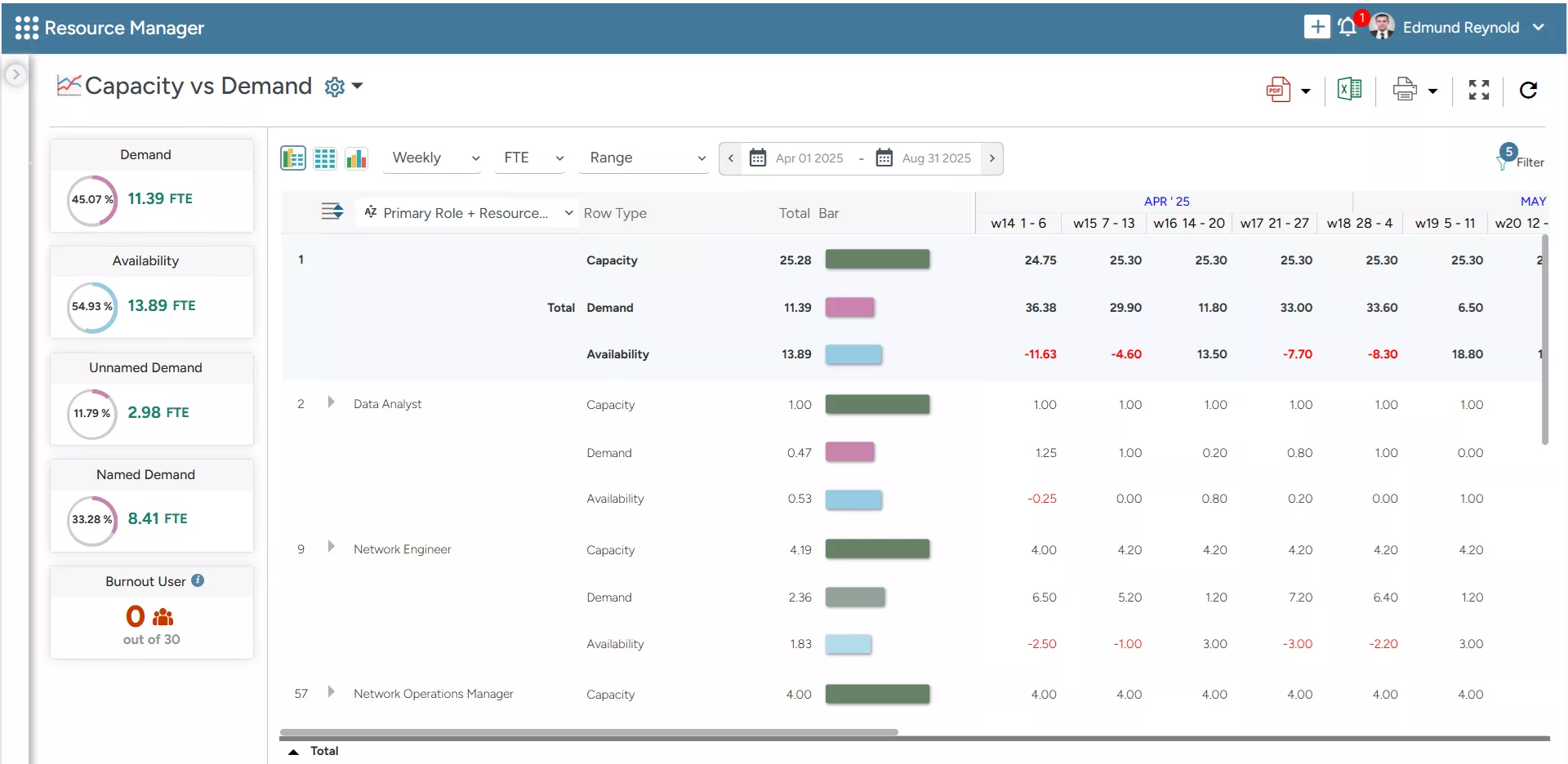
SAVIOM’s Capacity v/s Demand reporting screen helps forecast demand across different dimensions such as location, team, resources, etc.
A comprehensive demand and capacity planning process requires firms to centralize critical information from various systems and establish a single source of truth. It includes collating real-time data on key metrics such as skill sets, current and pipeline project schedules, workforce capacity, vacations, and non-project activities. This data helps them assess whether they can meet all their immediate and future project requirements.
Let’s understand this critical process through a resource capacity planning example.
Resource Capacity Planning Example
In an audit & accounting firm, there are five projects in the pipeline that have reached the probability stage. At this point, the resource managers begin the capacity planning process to understand whether they have the right talent to take on these upcoming opportunities.
Managers first gather the resource demand of these pipeline projects. This includes outlining the number of resources and their types, skillsets, expertise levels, and timelines required for the complete project lifecycle. Once they have these insights, managers look into the internal channels and thoroughly analyze the existing workforce capacity.
The next step involves a detailed comparison between the project resource demand and the available capacity to identify any skill gaps or shortages in the workforce. For instance, if Project A requires three senior auditors with expertise in financial audits and the firm only has two available, this is noted as a critical gap.
After identifying gaps, managers explore solutions to bridge these gaps. They consider options such as upskilling existing employees through targeted training programs, hiring temporary or permanent staff, or reallocating resources from other projects that are winding down.
Furthermore, managers perform scenario analysis to anticipate different outcomes and accordingly prepare contingency plans. This might involve creating a buffer for additional freelance consultants who can be called upon if there is an unexpected increase in workload or last-minute project scope changes.
By following a systematic resource capacity planning process, the audit & accounting firm can successfully manage multiple projects and ensure profitability.
Next, let’s learn how resource capacity planning differs from resource planning and capacity management.
The Role of Resource Capacity Planning in Project Management
The resource capacity planning model plays a vital role in project management. Let’s learn about its role in detail:
How Does Resource Capacity Planning Help Build an Optimized Project Team?
Once a pipeline project reaches a certain probability stage, the manager estimates the resource requirements and initiates the requisition process. This allows them to identify the resource shortages/excesses ahead of time.
Accordingly, they can apply appropriate strategies, such as hiring a permanent or contingent workforce, to ensure that the right people with the necessary skills and bandwidth are available for project initiation. Thus, it enables managers to create an optimal project team mix of permanent/contingent or junior/senior resources based on requirements.
How Does Resource Capacity Planning Affect Utilization?
Resource capacity planning directly impacts utilization by ensuring that the right resources with the appropriate skills are available to work on the right projects and tasks. This alignment maximizes employee productivity and utilization.
Moreover, efficient demand and capacity planning allows firms to forecast billable and strategic utilization ahead of time. Thus, it enables managers to mobilize resources from non-billable to revenue-generating tasks or projects, thereby enhancing profitable utilization.
How Does Resource Capacity Planning Impact Project Delivery?
Resource capacity planning significantly impacts project delivery by ensuring that the necessary resources, such as personnel, equipment, finances, tools, etc., are available and competently allocated throughout the project lifecycle. This helps avoid shortages or resource overallocation, which can lead to delays, increased costs, and compromised quality.
Moreover, aligning resources with project demands promotes optimal productivity and enhances the ability of the team to meet deadlines and deliverables. This ultimately leads to successful project outcomes and client satisfaction.
Next, let’s understand how a resource capacity plan benefits organizations.
5 Benefits of Resource Capacity Planning
Resource capacity planning helps businesses plan pipeline projects and future-proof the workforce against market volatility. Here are some of the advantages of resource capacity planning for your business:
Reduces Project Resource Costs Across the Enterprise
Resource capacity planning strategies empower businesses to forecast skill demand accurately and ensure requisite personnel are available ahead of the curve. This approach minimizes the need for last-minute, expensive recruitment and helps reduce project resourcing costs significantly.
Moreover, it provides managers sufficient lead time to identify and source the best-fit global resources from low-cost locations based on project requirements. This way, they can utilize cost-effective global resources optimally and ensure high-quality deliverables.
Read More: 5 Ways to Reduce Project Management Costs
Helps Forecast and Bridge the Skills Gap
Resource capacity planning allows firms to identify skill gaps ahead of time and take corrective actions to eliminate them. For instance, if there is a resource deficit, managers can hire a permanent or contingent workforce for long-term and short-term requirements, respectively. They can even upskill/retrain existing personnel to address the knowledge gap.
Moreover, they can adjust project start and end dates to align with the available capacity or mobilize resources across departments to ensure smooth workflow and timely delivery. In contrast, for resource excess, managers can bring forth strategic initiatives or sell extra capacity at discounted rates to prevent billable losses and maximize productivity.
Facilitates Skill-Based Resource Allocation
As per McKinsey & Company, “83% of executives identify resource allocation as the most critical management lever for spurring growth.”
Having the right-skilled employees available at the right time is crucial for a project to finish within the stipulated deadline and budget. With a robust resource capacity plan, managers can forward plan and identify competent resources for each project based on criteria such as skills, experience, qualifications, location, cost rate, etc.
This approach ensures that the “best-visible-best-fit” person is assigned to every project and task rather than simply allocating the “first-visible-first-fit” resource. As a result, it prevents skill mismatches and scheduling conflicts, such as double resource bookings and overloading, thereby ensuring the timely completion of projects.
Read More: What is Resource Allocation? A Comprehensive Guide for Project Success
Maximizes Productive Utilization of Every Resource
According to Gartner, “The ideal utilization rate for billable hours should be around 70-80%.”
Billable resource utilization is a critical KPI for businesses. Here, resource capacity planning helps organizations balance resource availability with the project demand. This process allows them to avoid under/overallocation and minimize idle time, billing losses, workload imbalances, etc.
Additionally, it enables resource managers to forecast billable and strategic utilization of the workforce ahead of time. Based on that, they can mobilize employees from non-billable or low-priority work to billable or high-priority projects. Thus, it helps firms to tap into their maximum potential and enhance profitable utilization.
Aligns Sales and Delivery by Forecasting Pipeline Opportunities
Resource capacity planning helps consider the forecasted and actual deals a company wins to estimate the resources. This process fosters coordination between the delivery and sales teams, enabling them to evaluate and assess the feasibility of sales pipeline opportunities. As a result, they gain a clear understanding of the project’s resource requirements and the client’s expectations.
By forward planning, the delivery team can ensure that the right resources are available at the right time to complete the project. This approach prevents the common issue of overcommitting and underdelivering due to sales-delivery misalignment, ensuring timely project initiation and enhancing client satisfaction.
Read More: Benefits of Capacity Planning in Professional Services Companies
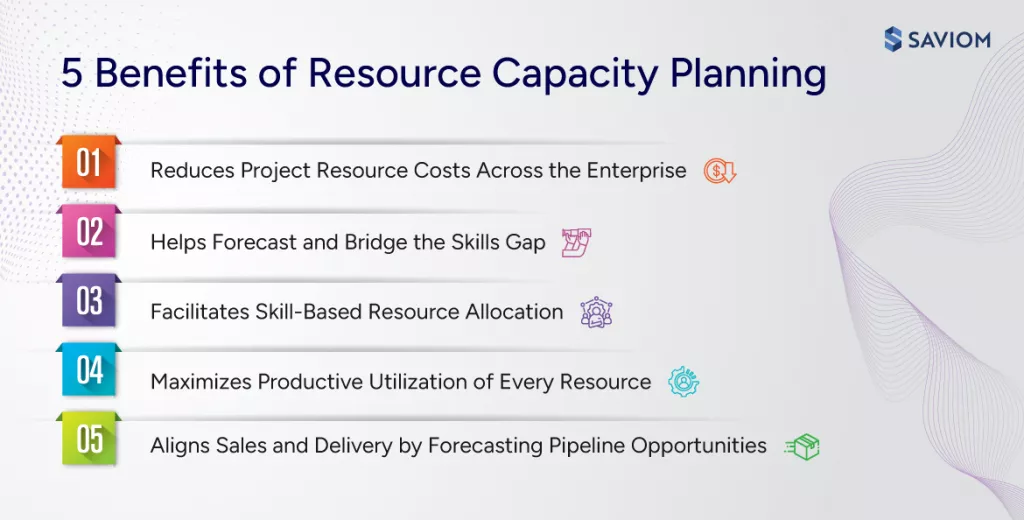
Now that the benefits are clear, let’s move on to learn some of the steps of team capacity planning.
Key Steps of Resource Capacity Planning Process
A well-defined resource capacity planning process includes the following steps:
Forecast Resource Demand
The first step is to accurately forecast the resource requirements of pipeline projects. For this, managers must carefully evaluate the project scope, tasks, budget, and timelines to determine the specific resources required for each activity. In other words, it involves understanding the skill sets, types, and duration of resources needed for the entire project lifecycle.
Assess the Resource Capacity
The next step is to assess the overall resource capacity for a specified period. Managers must look into internal and external channels to calculate the cumulative workforce capacity, which includes full or part-time employees, contractors, and temporary personnel. Moreover, they must also consider planned leaves, contract terminations, and ongoing recruitment to make an accurate assessment.
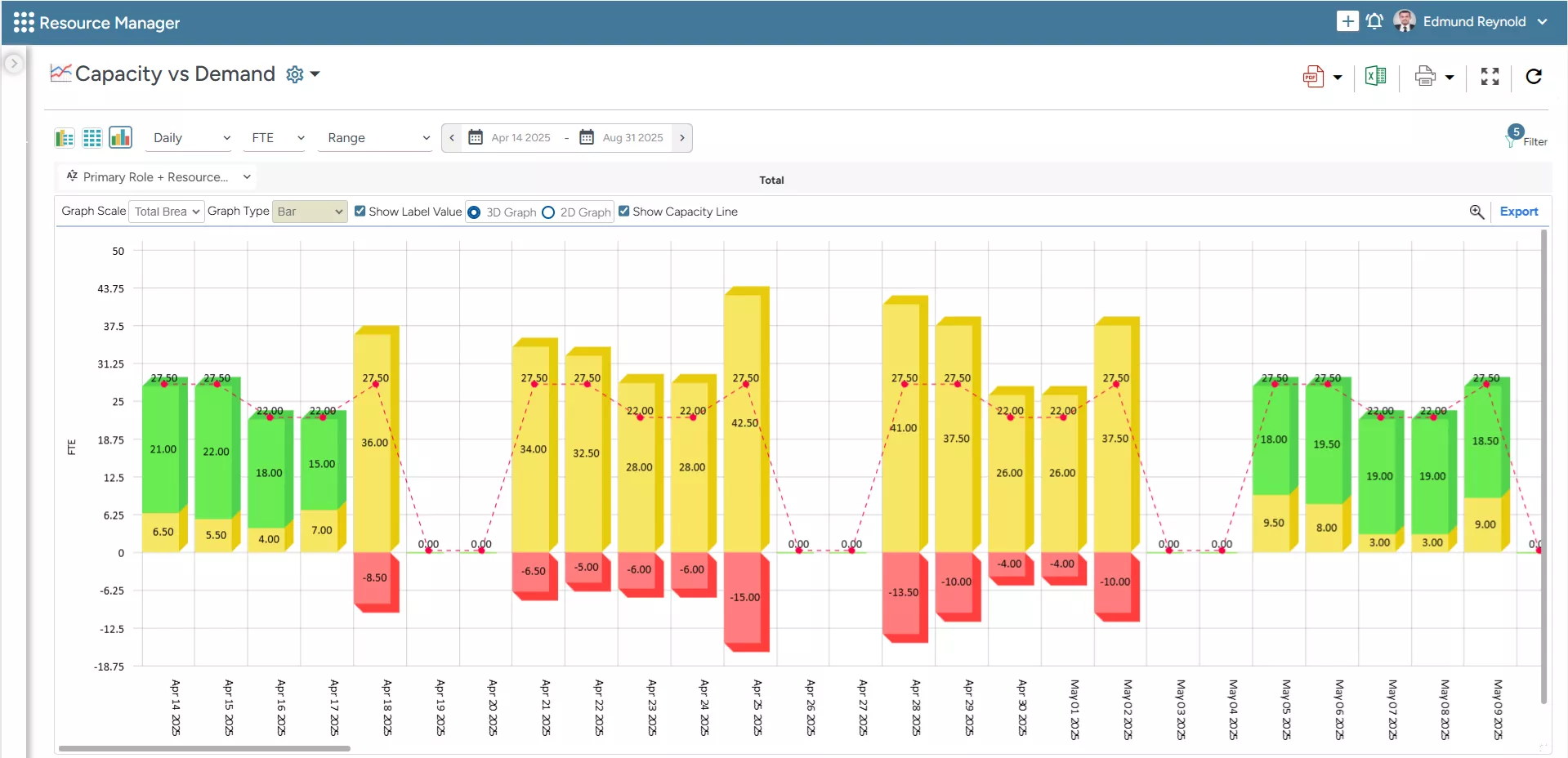
SAVIOM’s Capacity vs. Demand feature graphically displays resource capacity and demand patterns while highlighting resource shortages.
Perform Capacity vs. Demand Gap Analysis
Once the project demand and workforce capacity are calculated, managers must conduct a capacity vs. demand gap analysis. It helps them identify the gaps between the resources needed for future projects and the ones available within the organization. This allows managers to verify whether they have an excess or shortage of resource capacity.
Bridge the Demand Gaps
Based on the findings of the capacity analysis, managers can formulate a resource capacity plan to bridge the gap. For resource deficit, they can proactively initiate training/upskilling or staggered hiring to acquire the necessary skill sets. On the other hand, for resource surplus, they can bring forth project timelines or sell the extra capacity at discounted rates.
Read More: How to Measure Resource Capacity and Demand?
Review and Monitor Regularly
In an organization, resource supply and demand are constantly evolving due to factors such as changing client requirements, shifts in project priorities, workforce constraints, and market conditions. As a result, it’s critical to monitor and reassess the supply vs. demand gap periodically to ensure that the resource capacity plan reflects the ground realities. This allows organizations to take corrective measures early on and ensure they are always equipped with a future-ready workforce.
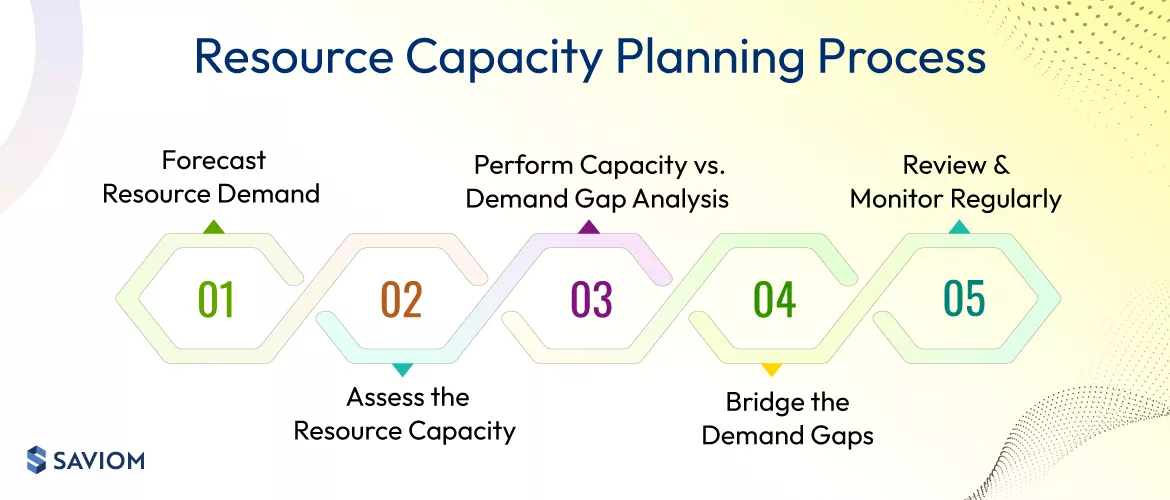
Now that we know the various steps involved in the resource capacity planning process, let’s understand the resource capacity planning strategies project managers must know.
Resource Capacity Planning Best Practices that Every Manager Must Know
Resource capacity planning in project management is becoming increasingly critical for a business to reduce resourcing costs and become responsive to the market.
Here are some key capacity planning strategies to implement an efficient capacity model in your firm:
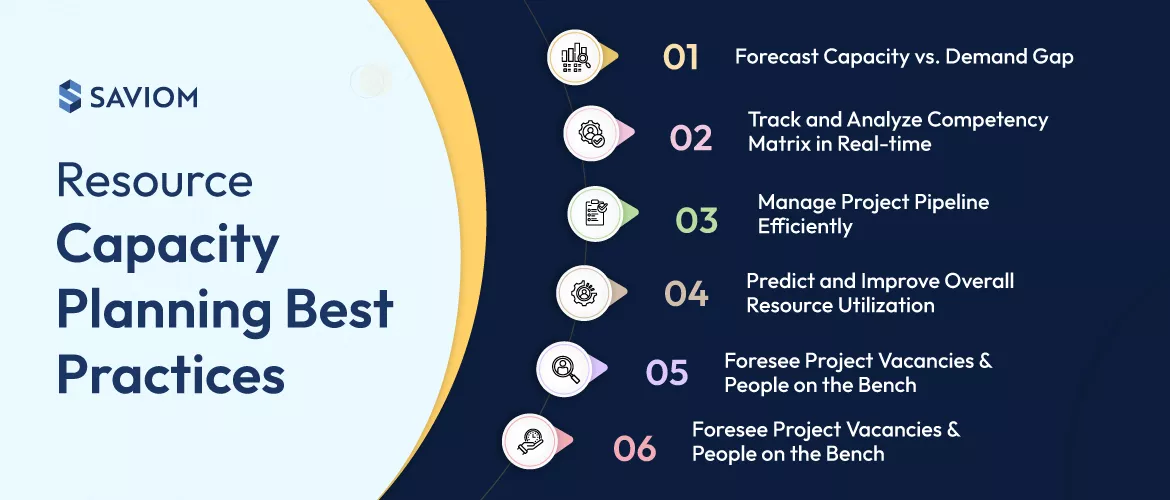
Forecast Capacity vs. Demand and Form a Project Resource Plan
A business must forecast capacity vs. demand from multiple dimensions, i.e., by role, department, team, location, skills, etc. It helps identify short- and long-term shortages/excesses of resources. This enables the managers to implement the right resourcing treatments to bridge the gap.
For instance, in case of shortages, organizations can facilitate retraining/upskilling resources or initiate recruitment to avoid last-minute hiring/firing costs. Conversely, when the resources are in excess, managers can either bring forward a project timeline or sell extra capacity to optimize resource utilization and ensure successful project delivery.
Read More: What is Project Resource Management, and How to Master it?
Track and Analyze the Competency Matrix in Real-time
Tracking and keeping up-to-date information about the workforce’s competencies and skills is critical for business efficiency. It allows the right resource with the right skill, experience, qualifications, cost rate, etc., to be allocated to the right project. Therefore, it helps in the competent allocation and utilization of the workforce.
Moreover, a competency matrix comes in handy when planning a new project. For instance, if the project needs a niche skilled resource, managers can look into the talent matrix to understand whether they have the competency in-house. If so, the resource can be out-rotated with a suitable backfill candidate so that the new high-priority project can be initiated on time without disrupting the ongoing one.
Manage Project Pipeline Efficiently
Businesses should keep track of potential projects in the pipeline and forecast estimated resource demand well in advance. Doing so helps organizations to ensure the resource pool is optimally balanced, skilled, and ready to meet the needs of new projects.
Managers can assess the pipeline project demands to determine whether they are one-off or recurring. Based on this assessment, they can decide whether to retrain current personnel, hire new employees, or deploy contingency resources to do the work. Additionally, it helps them create an optimal mix of permanent and contingent resources and overcome budget constraints.
Read More: 4 Steps to Perfect Your Project Pipeline Management Strategy
Predict and Improve Overall Resource Utilization
Organizations should forecast short-term and long-term billable, strategic, and overall utilization. It helps ensure equitable workload distribution and minimizes instances of under/overloading. For example, if resources are under-allocated, managers can bring forward some project timelines or sell excess capacity to optimize their utilization.
On the other hand, if resources are overallocated, they can adjust projects’ timelines to match the future availability, pull in additional team members, or initiate skill-based or project-specific hiring as required. This way, managers can take proactive measures to ensure optimal utilization levels of the workforce.
Foresee Project Vacancies and People on the Bench
Failure to find the right resources for the right project can cause you to lose an opportunity. Therefore, it’s important for companies to gain foresight into future resource needs to ensure all the projects are staffed with the right-skilled professionals.
Robust resource capacity plans help foresee both project requirements and people on the bench. Thus, it allows resource managers to mix and match benched personnel and allocate them to appropriate project vacancies to minimize idle time and billing losses.
Streamline Resource Requisition to Deliver Projects on Time
Conventionally, resource requisition is done through email or phone requests. This leads to chaos as it creates information silos regarding resource requests and allocations across various projects. Consequently, a resource may be booked for multiple projects beyond its capacity. Such scheduling conflicts can lead to employee burnout or power conflicts among project managers, resulting in delays.
Therefore, streamlining the process using an automated workflow is critical to ensure resources are allocated with appropriate approvals and notifications. In addition, one must avoid unnecessary emails/telephone calls as they cannot be easily reconciled, documented, and audited.
Read More: 6 Easy Steps to Request Resources Efficiently
In the following section, let’s learn how a modern capacity planner can help organizations improve their resource planning processes.
How Can a Resource Capacity Planning Software Help?
Effective capacity and resource planning is essential for improving the project and business performance. That’s why organizations must choose Saviom’s robust capacity planning software to move beyond the limitations of traditional solutions. Here is how it helps:
- The 360-degree visibility allows firms to gain insights into project pipelines and current and future resource schedules.
- The embedded capacity planner helps managers foresee future demand, identify skill shortages/excesses, and implement corrective measures to bridge the gaps.
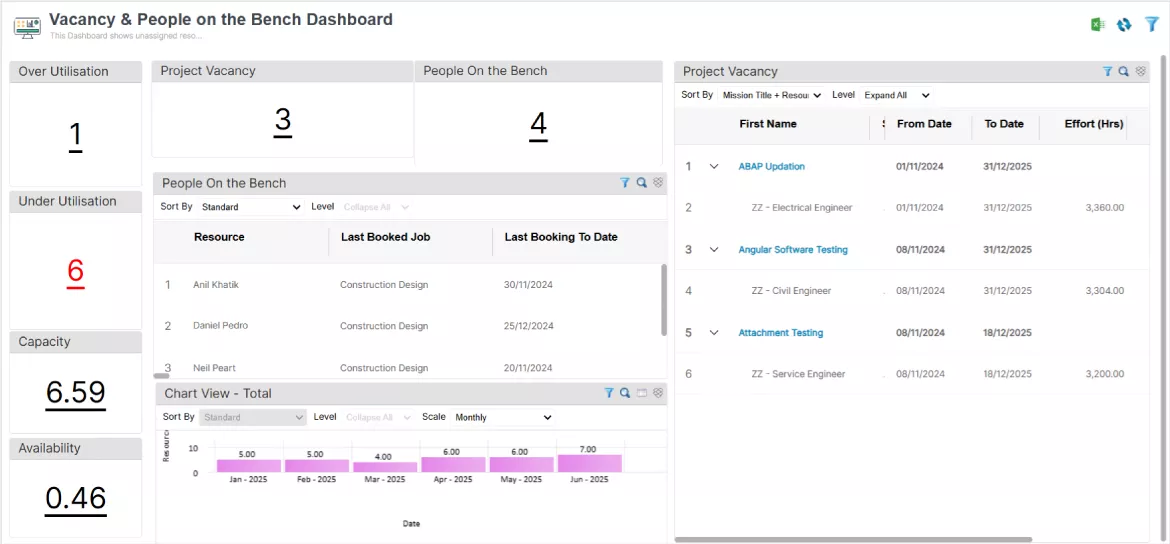
SAVIOM’s Advanced BI Dashboard helps eliminate last-minute resourcing chaos and deliver projects on time.
- An intelligent matchmaker and advanced filters allow supervisors to match resources to appropriate projects or tasks.
- The KPI Forecaster offers foresight into key resource metrics like availability, capacity, utilization, burnout, and skill gaps for proactive decision-making and helps keep projects on schedule.
- A competency matrix allows firms to store, track, and update resource information in real time. It helps them promptly identify and address skill gaps.
- Real-time BI reports, such as forecast vs. actual, project vacancy, people-on-the-bench, etc., provide granular insights that allow managers to implement corrective action to prevent deviations.
- Automated resource requisition workflow streamlines the requesting process and maintains an audit trail.
- The what-if analysis module helps simulate and compare scenarios to create the best-fit resource capacity plans, maximizing the potential of existing resources.
These advanced functionalities of a resource capacity tracker can empower organizations to improve their resource capacity model and make every project a success.
Read More: How Scott Automation Redefined Resource Forecasting with SAVIOM
Conclusion
Resource capacity planning is a crucial aspect of project resource management. By leveraging the functionalities of an advanced resource capacity planner, businesses can optimize team capacity and utilization. In addition, it helps reduce resourcing costs, eliminate reactive hiring, and future-proof their workforce against market volatility.
Book a 60-day customized trial with SAVIOM today!
The Glossary
Read More: Glossary of Resource Workforce Planning, Scheduling and Management






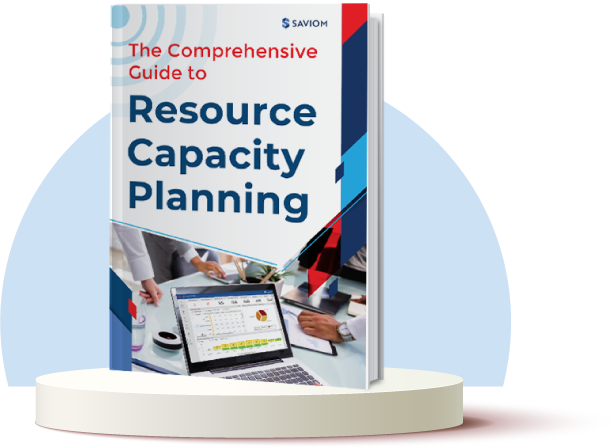







Leave a Reply